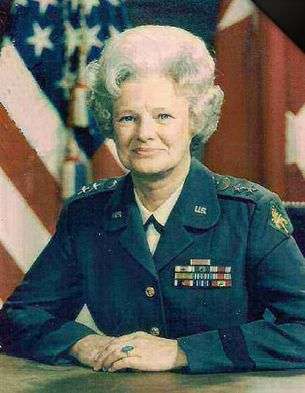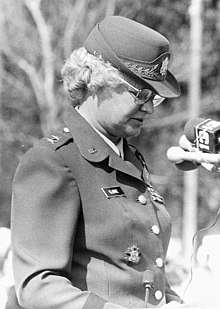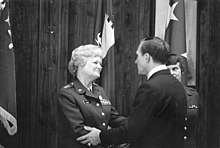Mary E. Clarke
Mary Elizabeth "Betty" Clarke (December 3, 1924 – June 10, 2011) was a United States Army officer who served as the director of the Women's Army Corps. She was the first woman to attain the rank of major general in the U.S. Army. Clarke served in the U.S. Army for 36 years, the longest service of any woman for a U.S. Army career.[2] Norwich University awarded her an Honorary Doctorate in military science in 1978.[2] Clarke retired in 1981 and was appointed to the Defense Advisory Committee on Women in the Services.[2]
Mary E. Clarke | |
|---|---|
 Clarke during the late-1970s | |
| Birth name | Mary Elizabeth Clarke |
| Nickname(s) | "Betty" |
| Born | December 3, 1924 Rochester, New York, U.S. |
| Died | June 10, 2011 (aged 86) San Antonio, Texas, U.S. |
| Buried | |
| Allegiance | |
| Service/ | |
| Years of service | 1945–1981 |
| Rank | |
| Unit | Women's Army Corps |
| Awards | |
| Other work | Defense Advisory Committee on Women in the Services |
Early life and education
Clarke was born in Rochester, New York on December 3, 1924.[3] She attended the Rochester Immaculate Conception Grammar School and Rochester West High School.[3]
Career
Clarke's first jobs were as a secretary and defense worker before she turned twenty-one.[1] On August 10, 1945, at the age of 21, she enlisted in the Women's Army Corps (WAC) just before World War II ended.[3] Clarke was expecting to serve until the war ended, plus a few additional months.[4] A male commander stated that it was unlikely she would even make it through the officers training program.[4] Clarke then decided to stay and made it through the initial training, served in the enlisted ranks for four years and was commissioned a second lieutenant in 1949. She went on to serve for 36 years making a career of the U.S. Army and the woman that has served the longest in the military.[4][5] Most of this time she spent in the Women's Army Corps.[3]
Clarke did her basic training at Fort Des Moines Provisional Army Officer Training School in Iowa.[6] Upon completion of basic training she was then immediately assigned to being a supply sergeant at Camp Stoneman, California. Her next assignment was in 1948 at Berlin, Germany. While in Berlin she was in the middle of the Berlin Airlift crisis.[3] She then served at the U.S. Army Chemical Center and Valley Forge General Hospital. Clarke then recruited for a year. Clarke attended the WAC Officer Candidate School at Camp Lee and after the schooling she became a WAC commissioned officer as a second lieutenant on September 29, 1949.[1] Then she served two years at a WAC unit as a commanding officer in Tokyo before going back to the United States.[3]
Clarke then held several officer's positions from 1958 through 1971 in Texas, Alabama, Maryland, California and Washington, D.C. In Washington, D.C., she worked at the Office of Equal Opportunity and Deputy Chief of Staff for Personnel. She also did WAC training and advisement.[6] Clarke was promoted to colonel in 1972 to become the commander of the U.S. WAC Center and School in Fort McClellan.[1] In 1974 she was the chief of the WAC Advisory Office. On 1 August 1975, Clarke became brigadier general and served as the final director of the WAC.[6] In 1976 she had special courses at the U.S. Military Academy Preparatory School to prepare women to attend military academies, since women were then allowed to attend by an executive order of President Gerald Ford.[3]
Clarke was the last director of the WAC (1975–1978) until it was dissolved at the end of her tenure in 1978.[7] After this assignment she was given the rank of a two-star general and promoted to major general in June 1978. She then immediately became commander of the U.S. Army Military Police School and Training Center upon leaving the WAC and during her tenure, oversaw the return of the U.S. Army Chemical School in 1979 to its former home. Now with three major missions, a basic Training Brigade, the Army Military Police School and the Army Chemical School, she became commander of The U.S. Army Military Police and Chemical Schools, Training Center, Fort McClellan, Alabama. [7][7][2][5] It was the first time a woman commanded a major Army post.[6] Clarke was the first woman to achieve the rank of major general in the U.S. Army.[8][9][10][5][11]
Later life and death

Clarke was director of human resources development for the Office of the Deputy Chief of Staff in Washington, D.C. in 1980. She was there until she retired in 1981.

Clarke died June 10, 2011, in San Antonio, Texas. She is buried at the Fort Sam Houston National Cemetery in Bexar County, Texas.[1]
Award and decorations
| 1st Row | ||||||
|---|---|---|---|---|---|---|
| 2nd Row | ||||||
| 3rd Row | ||||||
| 4th Row | ||||||
Promotions
- Enlisted – August 10, 1945








Notes
- "Maj. Gen. Mary E. Clarke – Extraordinary Soldier --Dies at 87". AUSA. United States Army. 2011-06-14. Archived from the original on 9 January 2014. Retrieved 11 January 2014.
- Read & Witlieb 1992, p. 92.
- Frank 2013, p. 149.
- Read & Witlieb 1992, p. 93.
- Baron 1998, p. 67.
- Morden, Bettie J. (1990). "The Women's Army Corps, 1945–1978". history.army.mil. Washington, D.C.: U.S. Army Center of Military History. Retrieved 2019-10-30.
- Frank 2013, p. 150.
- American Forces Press Service 1978, p. 20.
- Air Force 1978, p. 37, vol 61.
- US Army 1995, p. 9.
- Franck & Brownstone 1995, p. 540.
Bibliography
- Air Force (1978). Air Force Magazine. Air Force Association.CS1 maint: ref=harv (link)
- American Forces Press Service (1978). Command. American Forces Press Service.CS1 maint: ref=harv (link)
- Baron, Scott (1998). They Also Served: Military Biographies of Uncommon Americans. Military Information Enterprises. ISBN 978-1-877639-37-1.CS1 maint: ref=harv (link)
- Franck, Irene M.; Brownstone, David M. (1995). Women's world: a timeline of women in history. HarperPerennial. ISBN 978-0-06-273336-8.CS1 maint: ref=harv (link)
- Frank, Lisa Tendrich (2013). An Encyclopedia of American Women at War. ABC-CLIO. ISBN 978-1-59884-444-3.CS1 maint: ref=harv (link)
- Read, Phyllis J.; Witlieb, Bernard L. (1992). The Book of Women's Firsts: Breakthrough Achievements of Almost 1,000 American Women. Random House Information Group. ISBN 978-0-679-40975-5.CS1 maint: ref=harv (link)
- US Army (1995). Soldiers. United States Department of the Army.CS1 maint: ref=harv (link)
Further reading
- "Mary E. Clarke's Obituary on The Anniston Star". Legacy.com. The Anniston Star.